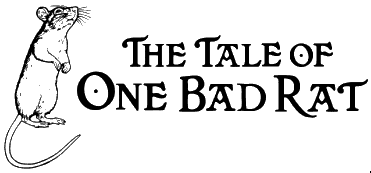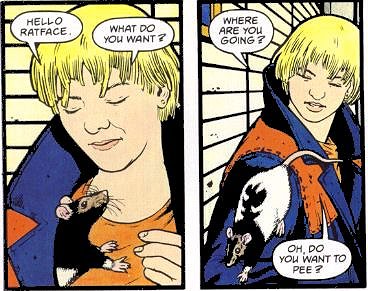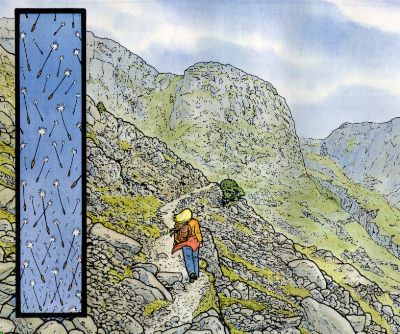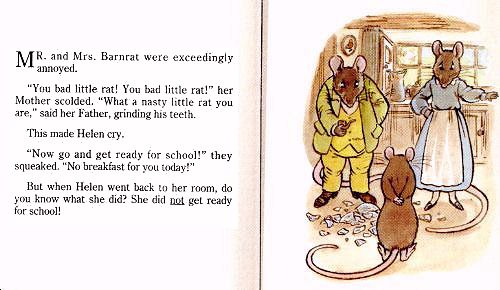
 The Tale of One Bad Rat
The Tale of One Bad Rat(Dark Horse)
128-page paperback, originally published in 4 parts
by Bryan Talbot
Rating:
![]() A strange thing happened to Bryan Talbot on his way to writing a book about the Lake
District.
A strange thing happened to Bryan Talbot on his way to writing a book about the Lake
District.
![]() Looking for a "hook", he got side-tracked into the world of former Lake District
resident Beatrix Potter,
the creator of the oh-so-charming anthropomorphic animal comics which people buy for
their young children as "storybooks". Then, trying to create a modern character to
focus his travelogue around, he got side-tracked into an "issue" story. Fortunately,
these unexpected detours often make for the most interesting journeys.
Looking for a "hook", he got side-tracked into the world of former Lake District
resident Beatrix Potter,
the creator of the oh-so-charming anthropomorphic animal comics which people buy for
their young children as "storybooks". Then, trying to create a modern character to
focus his travelogue around, he got side-tracked into an "issue" story. Fortunately,
these unexpected detours often make for the most interesting journeys.

![]() The Tale of One Bad Rat is about a homeless adolescent girl named Helen and
her pet rat. Like most girls (as well as many boys) on the street, she ran away
from home to escape sexual abuse from a family member. And like so many runaway Britons,
she ran to London, where we find her in a tube station, begging... and blaming herself.
The Tale of One Bad Rat is about a homeless adolescent girl named Helen and
her pet rat. Like most girls (as well as many boys) on the street, she ran away
from home to escape sexual abuse from a family member. And like so many runaway Britons,
she ran to London, where we find her in a tube station, begging... and blaming herself.
![]() The first section tells of her experiences in the city, both good and bad. Through
these encounters, some well-executed flashbacks, and a series of imaginative visions,
we begin to get a picture of this fresh-faced young woman and the demons that haunt her.
We also get to know (and to a lesser extent, understand) the rat she keeps with her, the
only "person" she allows close enough to touch her. "They're cleaner than people!"
she explains in a rare moment of openness with her new-found friend Ben. "No, they've
just had a really bad press."
The first section tells of her experiences in the city, both good and bad. Through
these encounters, some well-executed flashbacks, and a series of imaginative visions,
we begin to get a picture of this fresh-faced young woman and the demons that haunt her.
We also get to know (and to a lesser extent, understand) the rat she keeps with her, the
only "person" she allows close enough to touch her. "They're cleaner than people!"
she explains in a rare moment of openness with her new-found friend Ben. "No, they've
just had a really bad press."
![]() I've already "spoilt" the fact that this book is (sort of) about the Lake District,
so you've probably figured out that Helen eventually makes her way north. On the way,
we learn more about the frightening events that led her to leave home. But through
this dark journey, she finally arrives in the same land that inspired the shy Miss Potter
to overcome her repressive childhood, and create a series of beautiful "Tales"
books, the most famous being The Tale of Peter Rabbit.
I've already "spoilt" the fact that this book is (sort of) about the Lake District,
so you've probably figured out that Helen eventually makes her way north. On the way,
we learn more about the frightening events that led her to leave home. But through
this dark journey, she finally arrives in the same land that inspired the shy Miss Potter
to overcome her repressive childhood, and create a series of beautiful "Tales"
books, the most famous being The Tale of Peter Rabbit.

![]() The Lake District,
an area in northwest England whose natural beauty has inspired many poets and other
writers, genuinely is a wondrous place. More than a dozen years later, it's one
of the places I remember most vividly and fondly from my cycling tour of Great Britain.
(Talbot, who as a native has seen far more of Britain than I, expresses similar feelings
in his comments at the back of the book.) I can vouch for the authenticity of Talbot's
scenery... but frankly, I don't think he really captured the ruggedly diverse beauty of
the area. I suppose I shouldn't expect the impossible from pen, ink, and (I assume)
watercolors. {smile}
The Lake District,
an area in northwest England whose natural beauty has inspired many poets and other
writers, genuinely is a wondrous place. More than a dozen years later, it's one
of the places I remember most vividly and fondly from my cycling tour of Great Britain.
(Talbot, who as a native has seen far more of Britain than I, expresses similar feelings
in his comments at the back of the book.) I can vouch for the authenticity of Talbot's
scenery... but frankly, I don't think he really captured the ruggedly diverse beauty of
the area. I suppose I shouldn't expect the impossible from pen, ink, and (I assume)
watercolors. {smile}
![]() Nonetheless, authentic realism was clearly one of Talbot's priorities. The characters
are all based (visually) on real people (Helen's personality is a composite of both Potter
and several abuse victims), and the various scenes take place in real locations in London
and the Lake District. Not only does this serve the serious, real-life aspect of the
story he's telling, the straightforward artistic style also reflects Potter's imaginary
stories, which included scenes drawn from real places, in simple but detail-sensitive
illustrations. It also makes the book more accessible to those not accustomed to the
usual stylistic idiosyncrasies of the comic-book medium.
Nonetheless, authentic realism was clearly one of Talbot's priorities. The characters
are all based (visually) on real people (Helen's personality is a composite of both Potter
and several abuse victims), and the various scenes take place in real locations in London
and the Lake District. Not only does this serve the serious, real-life aspect of the
story he's telling, the straightforward artistic style also reflects Potter's imaginary
stories, which included scenes drawn from real places, in simple but detail-sensitive
illustrations. It also makes the book more accessible to those not accustomed to the
usual stylistic idiosyncrasies of the comic-book medium.
![]() The use of various regional British accents and slang can make the dialog a little difficult
to follow; it may help to read it aloud (provided you can "do" credible British accents).
It does enhance the realism, however.
The use of various regional British accents and slang can make the dialog a little difficult
to follow; it may help to read it aloud (provided you can "do" credible British accents).
It does enhance the realism, however.
![]() It's here in the Lake District that Helen must face the influences that are suppressing her
and her creative potential. Some of the plot developments seem a little too "convenient"
toward this end, but they serve to move along a character development that is as
dramatic as it is moving. The steep, often-rocky fells and the still, deep waters of the
meres serve as the perfect (somewhat symbolic) backdrop for all this.
It's here in the Lake District that Helen must face the influences that are suppressing her
and her creative potential. Some of the plot developments seem a little too "convenient"
toward this end, but they serve to move along a character development that is as
dramatic as it is moving. The steep, often-rocky fells and the still, deep waters of the
meres serve as the perfect (somewhat symbolic) backdrop for all this.

![]() Just before the end of the story, Talbot inserts a short "lost" Potter story (entitled,
in case you hadn't guessed, The Tale of One Bad Rat), which serves as an allegory
for Helen's life. It's been a while since I've read any real Potter, but it seems true
to her style, both narratively and illustratively. Again, its appearance here is a bit
contrived, but it serves as a nice catalyst for the final, beautiful scene.
Just before the end of the story, Talbot inserts a short "lost" Potter story (entitled,
in case you hadn't guessed, The Tale of One Bad Rat), which serves as an allegory
for Helen's life. It's been a while since I've read any real Potter, but it seems true
to her style, both narratively and illustratively. Again, its appearance here is a bit
contrived, but it serves as a nice catalyst for the final, beautiful scene.
![]() Yes, The Tale of One Bad Rat is an "important" book, looking at the taboo of incest,
by peeling away the far larger taboo against discussing it. But it's also an
award-winning, engaging story, told poignantly through subtle characterisation and some
beautiful art.
Yes, The Tale of One Bad Rat is an "important" book, looking at the taboo of incest,
by peeling away the far larger taboo against discussing it. But it's also an
award-winning, engaging story, told poignantly through subtle characterisation and some
beautiful art.
![]()

![]() This book can be discussed in rec.arts.comics.alternative
This book can be discussed in rec.arts.comics.alternative
![]() More reviews of all kinds of comics
More reviews of all kinds of comics
![]() More reviews of comics that go Beyond Genre
More reviews of comics that go Beyond Genre
![]() The main Beek's Books menu
The main Beek's Books menu
![]() Comments?
Comments?
© Todd VerBeek, Radio ZeroTM